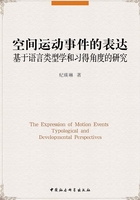
CHAPTER 2 Encoding motion events:typological and developmental perspectives
2.1 LEXICALIZATION PATTERNS OF MOTIONEVENTS ACROSS LANGUAGES
It has long been observed by linguists that verbs used in constructions referring to moving objects in space can vary in terms of their semantic value.The early literature on this point mainly concerns Indo-European languages and can be traced back to the time of stylistique comparée(‘comparative stylistics’) of French and German.For instance, Tesnière (1959) classifies verbs of motion into two categories, Mouvement(‘Motion’) and Déplacement(‘Displacement’).The former denote, in Tesnière's terms, the somatic conditionsof moving objects and include French verbs such as ramper(‘crawl’ or ‘creep’), galloper(‘gallop’), sauter(‘jump’), courir(‘run’); the latter express concepts associated with the spatial ground with respect to which the motion takes place as with verbs such as monter(‘ascend’), descendre(‘descend’), entrer(‘enter’) and sortir(‘exit’) (qtd.in Berthele 2004: 94 and Wälchli Unp.Ms.: 3).